
AoT Valley of the Sun is back for the next event in our monthly series! This October, we’re thrilled to hear from ASU Professor Jim Bell and PhD student Hailey Nelson about an ASU-led mission to the asteroid Psyche. (1/2)
03.10.2025 15:16 — 👍 5 🔁 2 💬 1 📌 0
30.09.2025 20:06 — 👍 1 🔁 0 💬 0 📌 0
I had a wonderful time speaking with @startswithabang.bsky.social and @luiswel.bsky.social about biosignatures, exciting sub-Neptune science, and why we should care about studying exoplanets!
Check out our podcast episode here:
13.08.2025 07:21 — 👍 5 🔁 1 💬 0 📌 0
Thanks for the shout-out!
10.07.2025 19:44 — 👍 0 🔁 0 💬 0 📌 0
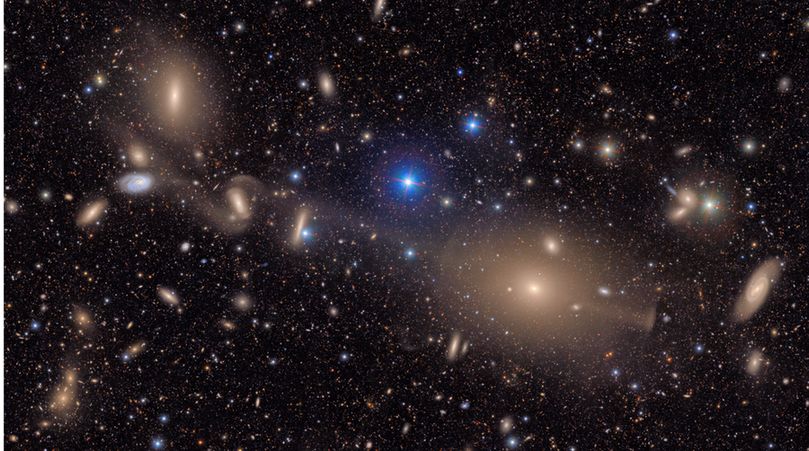
A sprawling, textured field of galaxies scattered across the deep black of space. It is filled with the delicate smudges and glowing cores of galaxies of many shapes, sizes and colors, as well as the bright multi-colored points of stars. The image focuses on a collection of interacting galaxies connected by delicate streams of stars. At top center lies a large elliptical galaxy that is dense and smooth, like a polished stone glowing with golden light. Like delicate spider silk or stretched taffy, these stellar bridges link the large elliptical to the few larger galaxies beneath, evidence of past collisions.
All throughout the image, thousands of galaxies gather in clusters or are spread throughout, like glittering gems strewn on a table. Some are sharp-edged and spiral, like coiled ribbons; others round and diffuse, like polished pebbles. Still others are just smudges of various colors against the black of space. The background is peppered with pinpoint stars in reds, yellows, and blues, crisp against the velvet black.
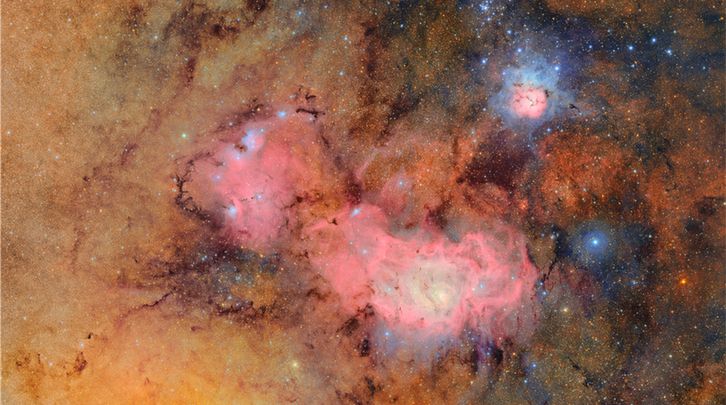
A cosmic tapestry of glowing tan and pink gas clouds with dark dust lanes. In the upper right, the Trifid Nebula resembles a small flower in space. Its soft, pinkish gas petals are surrounded by blue gas, and streaked with dark, finger-like veins of dust that divide it into three parts. It radiates a gentle, misty glow, diffuse and soft like the warmth of breath on a cold hand. To the lower left, the much larger Lagoon Nebula stretches wide like a churning sea of magenta gas, with bright blue, knotted clumps sprinkled throughout where new stars are born. Both nebulae are embedded in a soft tan backdrop of gas that is brighter on the left than on the right, etched with dark tendrils of dust and sprinkled with the pinpricks of millions of stars.
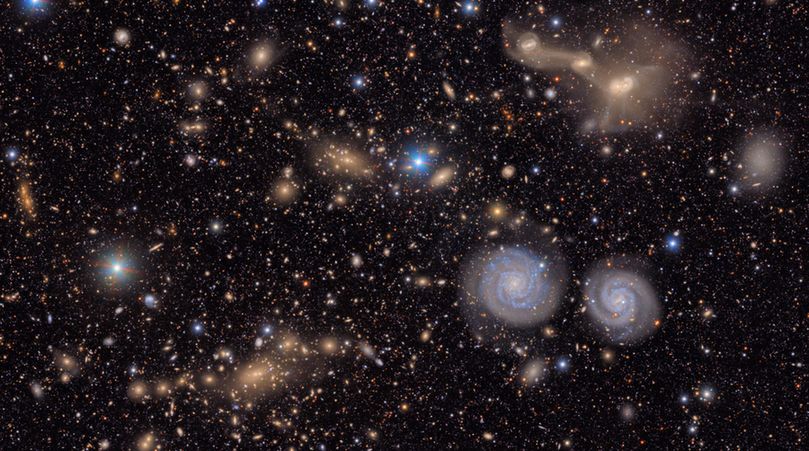
A sprawling, textured field of galaxies scattered across the deep black of space. It is filled with the delicate smudges and glowing cores of galaxies of many shapes, sizes and colors, as well as the bright multi-colored points of stars. To the lower left is a region filled with the hundreds of golden glittering gems of a distant galaxy cluster. In the foreground, below and right of center, two blue spiral galaxies look like eyes beneath the entangled mass of a triple galaxy merger in the upper right. A few bright blue points of foreground stars pierce the glittering tapestry.
All throughout the image, thousands of galaxies gather in clusters or are spread throughout, like glittering gems strewn on a table. Some are sharp-edged and spiral, like coiled ribbons; others round and diffuse, like polished pebbles. Still others are just smudges of various colors against the black of space. The background is peppered with pinpoint stars in reds, yellows, and blues, crisp against the velvet black.
Introducing...your sneak peek at the cosmos captured by NSF–DOE Vera C. Rubin Observatory!
Can you guess these regions of sky?
This is just a small peek...join us at 11am US EDT for your full First Look at how Rubin will #CaptureTheCosmos! 🔭🧪
#RubinFirstLook
ls.st/rubin-first-look-livestream
23.06.2025 04:06 — 👍 703 🔁 333 💬 22 📌 105
I agree with you that saying K2-18 b “can’t” have an ocean or “isn’t” an ocean world is a stretch - we can’t totally rule it out with the present data, but it does appear that Neptune-like or gas dwarf models are consistent with what we know about the planet and require much less fine-tuning
25.05.2025 17:29 — 👍 5 🔁 1 💬 1 📌 0
It’s tricky to maintain a thin (~a few bar) H2 atmosphere over Gyr timescales near the intense XUV environment of an M star. This aspect is under-explored as far as I’m aware but is mentioned by e.g. Wogan et al. 2024. You definitely need a lot of model fine-tuning to maintain a thin H2 atmosphere
25.05.2025 17:26 — 👍 4 🔁 0 💬 1 📌 0
There are a number of factors which challenge the ocean world hypothesis for K2-18 b. Due to its bulk density, the planet would need to be ~90% H2O by mass to sustain a liquid ocean. Based on analysis of the outer solar system, it’s tricky to see how a planet would form with >>50% H2O
25.05.2025 17:18 — 👍 3 🔁 0 💬 1 📌 0
Definitely some kind of space needed, otherwise you’d end up with 51 Pegasib and 55 Cancrie
24.05.2025 19:56 — 👍 2 🔁 0 💬 0 📌 0
Congratulations!!! I enjoyed (virtually) attending your thesis defence btw, great talk!
18.05.2025 22:41 — 👍 1 🔁 0 💬 1 📌 0

A Systematic Search for Trace Molecules in Exoplanet K2-18 b
The first transmission spectrum of the habitable-zone sub-Neptune K2-18 b with JWST has opened a new avenue for atmospheric characterisation of temperate low-mass exoplanets. The observations led to i...
Good to see Pica-Ciamarra, Madhu+ engage with our work and correct claims from last month. Following our recommendation to expand the model space, they now find: ‘No molecule reaches 2σ significance when allowing for an offset…’ 𝐍𝐨 𝐛𝐢𝐨𝐠𝐚𝐬𝐞𝐬 𝐚𝐟𝐭𝐞𝐫 𝐚𝐥𝐥! Sec. 4.4 arxiv.org/abs/2505.10539 🔭 #exoplanets
16.05.2025 21:35 — 👍 18 🔁 4 💬 1 📌 0
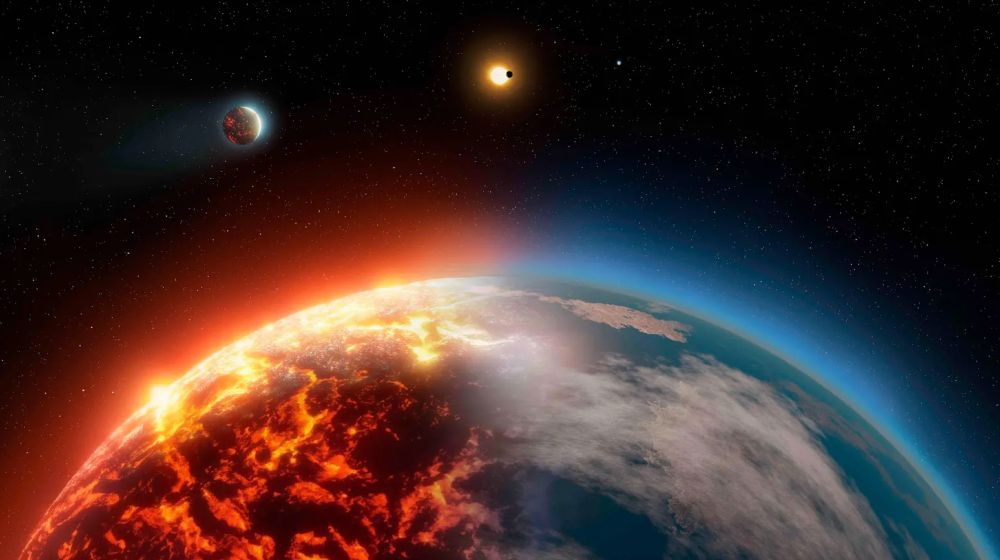
Image credit: Mark Garlick
Within the context of the interdisciplinary PRELIFE consortium me and Wim van Westrenen are advertising a joint PhD position on the surface water levels and atmospheric composition of the earliest Earth: www.formingworlds.space/phdposition2.... Deadline: 10th June. Please share! 🌋🌏🧬
14.05.2025 15:51 — 👍 7 🔁 4 💬 0 📌 2
Thanks so much for this great summary! Also, happy birthday for yesterday!!! Sorry I didn't realise until today 🎂
02.05.2025 01:32 — 👍 1 🔁 0 💬 0 📌 0
A real pleasure to chat about our latest work and all things exoplanet atmospheres!
02.05.2025 01:31 — 👍 5 🔁 0 💬 0 📌 0
But in the mean time, we need to take a careful approach to interpreting the spectra that we have, and keep in mind the limitations of our models as well as the impact of what possibilities we do and don’t consider. That way, we can make sure we’re building towards truly understanding these worlds.
02.05.2025 01:29 — 👍 2 🔁 0 💬 1 📌 0
So, if we can't confirm the presence of propyne, or indeed anything, in the atmosphere of K2-18 b from this spectrum alone, what do we do? Of course, more observations would help, both to make sure there's a real signal from the planet, and to disentangle the different gases that could explain it.
02.05.2025 01:29 — 👍 2 🔁 0 💬 1 📌 0
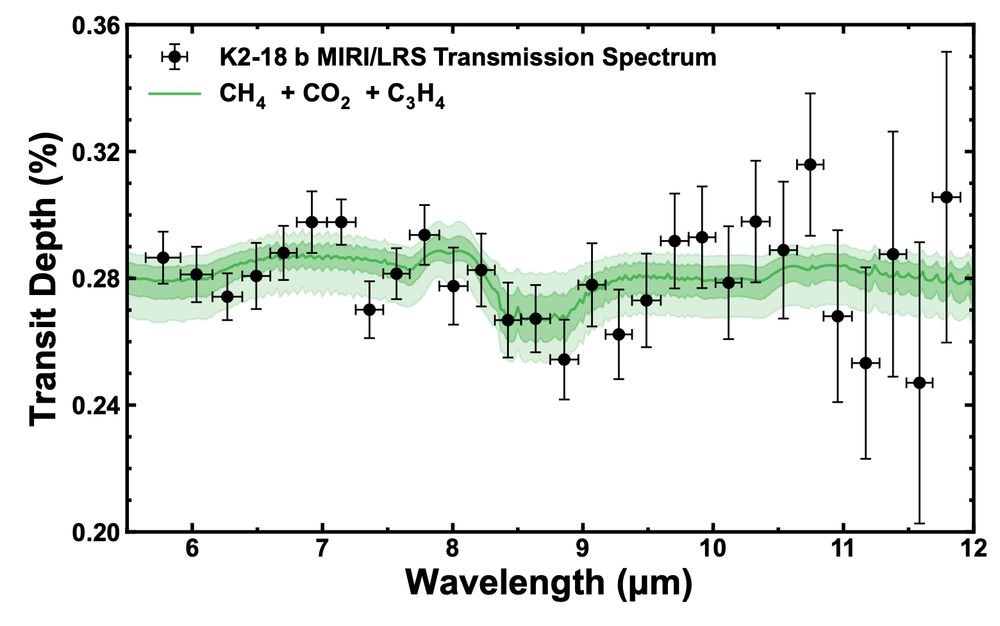
JWST transmission spectrum of K2-18 b, with models including methane, carbon dioxide, and propyne. While this model can explain the data, the signal to noise ratio isn't good enough to uniquely identify these or any other chemical species.
The gas that came closest to explaining the observations out of everything we tested was propyne (C3H4), a hydrocarbon found on Neptune that hadn’t been tested before for K2-18 b. But it still fell far short of what we would consider a detection.
02.05.2025 01:29 — 👍 3 🔁 0 💬 1 📌 0

Table of different hydrocarbons, showing how many of them can be "detected" on K2-18 b, but only if you compare them to a limited model with a small number of possible gases.
In fact, by those same Bayesian metrics mentioned earlier, we found that we could “detect” a whole range of gases, as long as you only compared them against a model with most other gases excluded. But if you test all of them together, those supposed detections vanish, even for DMS and DMDS.
02.05.2025 01:29 — 👍 3 🔁 0 💬 1 📌 0
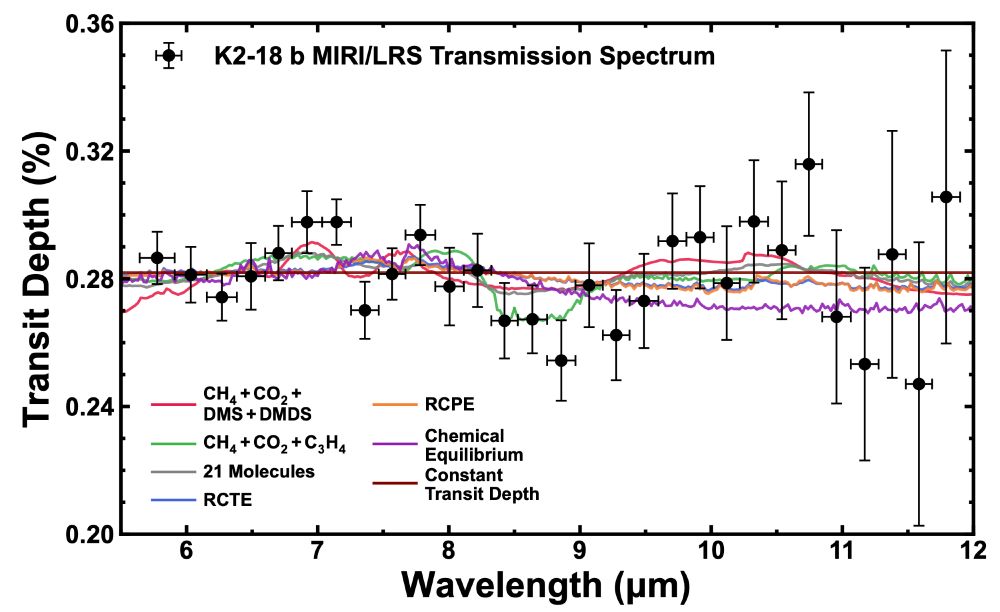
JWST transmission spectrum of K2-18 b, with lots of models that can all provide a reasonably good explanation of the data.
We found that, due to the small signal size and high measurement uncertainty, anything from a collection of gases to random noise can explain the data. There just isn’t enough information in the spectrum to reach strong conclusions. But that only becomes clear if you test a large set of models.
02.05.2025 01:29 — 👍 3 🔁 0 💬 1 📌 0

Absorption cross-sections of several chemical species, including dimethyl sulphide (DMS), dimethyl disulphide (DMDS), and a number of hydrocarbons.
However, that initial analysis only considered a small set of chemical species in their atmospheric model. So we tried a range of alternative models, and considered dozens of chemical species that weren’t explored in previous work, some of which we might expect to see on this planet, others less so.
02.05.2025 01:29 — 👍 3 🔁 0 💬 1 📌 0
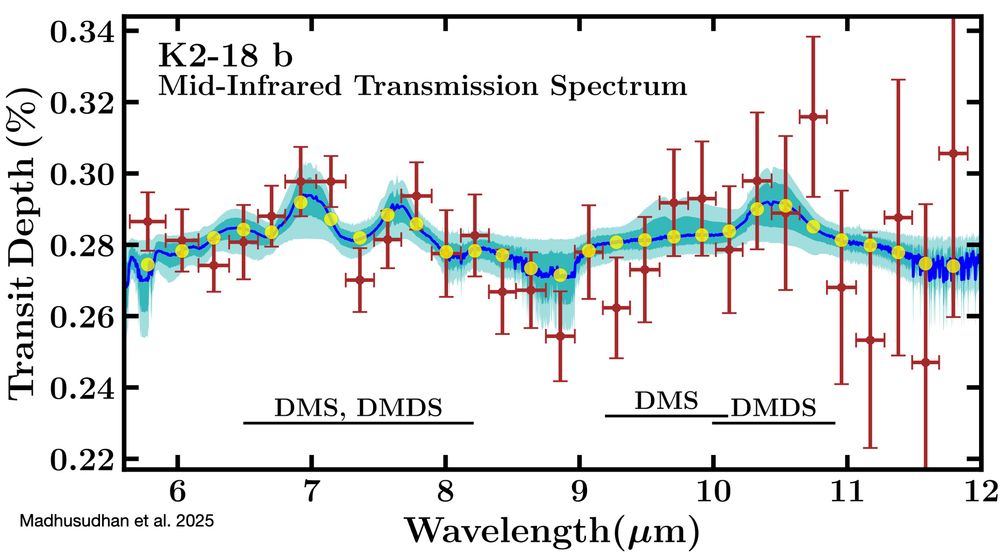
JWST transmission spectrum of the sub-Neptune K2-18 b.
As a case study, we investigate recent claims of a potential biosignature detection on K2-18 b. For K2-18 b, previous work found that a model including DMS and DMDS – gases proposed as potential biosignatures - outperformed a model without those chemicals, according to a Bayesian model comparison.
02.05.2025 01:29 — 👍 3 🔁 0 💬 1 📌 0
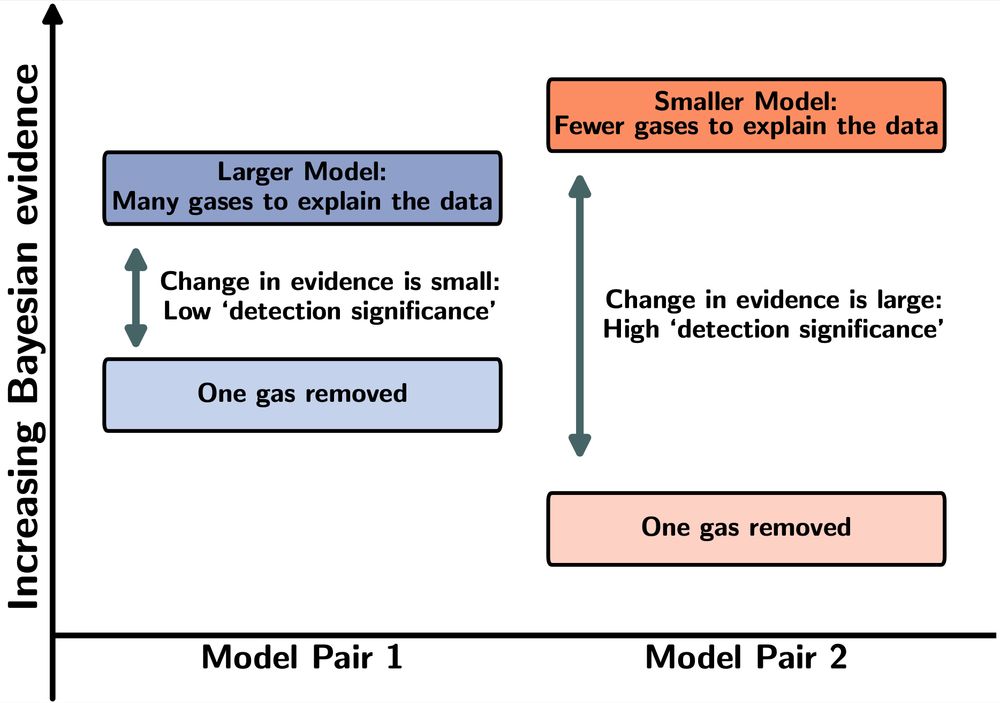
Diagram showing how the apparent significance of a "detection" can change depending on how many alternative explanations you build in to your model.
In exoplanet atmospheres, we often use Bayesian statistics to figure out if we have detected a gas. This is a powerful tool, but it comes with caveats. We can use it to compare the performance of two models, but just because one outperforms the other, doesn’t mean that either is necessarily “right”.
02.05.2025 01:29 — 👍 8 🔁 0 💬 1 📌 2
However, we're naturally driven to test the limits of what our telescopes can see. For JWST, this means observing small planets like sub-Neptunes, and trying to spot gases with weaker spectral signatures. When we're close to these limits, we have to be careful in how we interpret tentative signals.
02.05.2025 01:29 — 👍 2 🔁 0 💬 1 📌 0
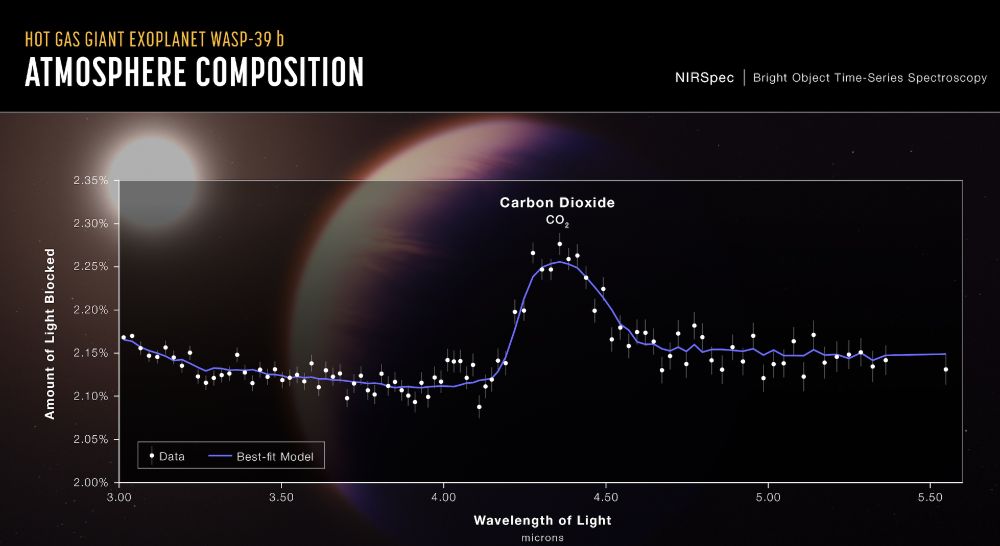
Spectrum of the atmosphere of a giant exoplanet, WASP-39 b, showing a strong carbon dioxide feature.
To start, it’s important to recognise the amazing observations of exoplanet atmospheres we’re getting from JWST. This has allowed us to find strong evidence of several chemical species that were really hard to detect in the past, like methane and carbon dioxide.
02.05.2025 01:29 — 👍 3 🔁 0 💬 1 📌 0
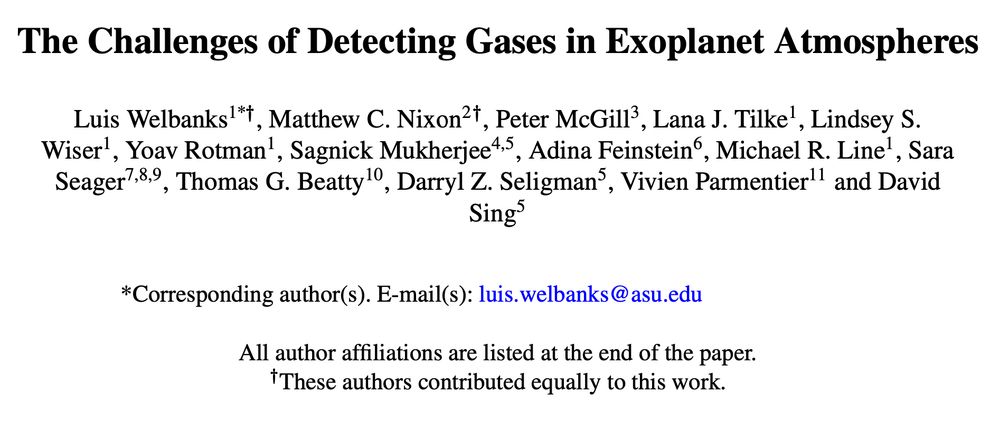
Just shared a new paper on the arXiv, led my @luiswel.bsky.social and me, on the challenges associated with detecting gases in exoplanet atmospheres. As the field pushes towards new and exciting opportunities, we thought it was time to talk about what it really means to “detect” something!
02.05.2025 01:29 — 👍 31 🔁 7 💬 1 📌 2
Thank you!!!
28.03.2025 18:23 — 👍 0 🔁 0 💬 0 📌 0
Thank you very much!!! 🪐🪐🪐
28.03.2025 04:07 — 👍 1 🔁 0 💬 0 📌 0
Lecturer in Astrophysics at the University of Bristol. I use numerical models to study planetary climates. Views are my own. He/him.
https://dennissergeev.github.io
ORCiD: 0000-0001-8832-5288
Exo-planet enthusiast. Prof. at Leiden Observatory and SRON. Pet lover <3
Postdoc @ MIT EAPS • Exoplanet Atmospheres • Habitability • Planet-Star Modeling
Postdoc MIT. PhD University of Amsterdam
I study the atmospheres of exoplanets. I am specifically interested in young transiting planets.
Official account of the Tempe, AZ chapter of Astronomy on Tap.
🍻Join us every month for drinks, astronomy, and good times!
🔭 Follow for announcements about upcoming events, topics, and speakers!
Professor of Astrophysics at the University of Oxford. I study the atmospheres of other worlds beyond the Solar system.
Astrophysics PhD student at the university of Oxford studying exoplanet atmospheres
🇨🇭
• ESO fellow @eso.org exploring exoplanet atmospheres 🪐 🔭 🇩🇪
• PhD from Lund Observatory 🇸🇪 & ESO 🇨🇱
• passionate about all things outreach and science communication ✨
she/her. (Exo)planetary clouds/hazes. Sagan Fellow at NASA GSFC/STScI --> Asst. Prof of Astro at UMD starting Fall 2026.
Opinions all me and only me.
Still screaming inside my heart.
https://tx.ag/moran
NancyRomanSci is managed by the Roman Science Centers and provides researchers with the most up-to-date information related to doing science with NASA's Nancy Grace Roman Space Telescope
Assistant Professor at the University of Arizona. Astronomer. Aunty.
She/Her.
https://bemiles.github.io/
infraredastronomy.tumblr.com
star guy, working for the astronomy community
🔭👩💻 Postdoctoral researcher in the APEx (Atmospheric Physics of Exoplanets) department at @mpi-astro.bsky.social in Heidelberg 🇩🇪
🪐🌍 Exploring exoplanetary interiors & atmospheres
Astrophysicist and rock-enjoyer. Slartibartfast's apprentice. Postdoc at ARCO, Open University of Israel. PhD from UNLV. Northwestern University Alumni.
Physicist/planetary scientist/astrobiologist based at Harvard. Soccer dad in training. Social media native since 2024.
Science journalist is just a fancy way of saying "professional nerd." USian in Austria, language geek, collector of fine yellow zigzagged sweaters and etymology fun facts. Get my newsletter about big questions in science: www.reviewertoo.com 👽🌀🦋
🇸🇪 Exoplanet atmospheres + chemistry + formation at Uppsala University 🪐🔭 Also into astrobiology, policy, climate, equality/EDI, and scicomm ✨ (she/her) – linnboldtchristmas.wordpress.com
Professor of astrophysics / planetary science / meteoritics at Arizona State University.
PhD student @ Instituto de Astrofísica de Canarias. I look for exoplanets, but I am generally fond of numerical modelling. I tend to post in EN/ES/BG.

















